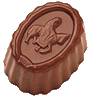The History of Chocolate
 The
first recorded evidence of chocolate as a food product goes back to
Pre-Columbian Mexico. The Mayans and Aztecs were known to make a drink
called "Xocoatll from the beans of the cocoa tree. In 1528, the
conquering Spaniards returned to Spain with chocolate still consumed as a
beverage. A similar chocolate drink was brought to a royal wedding in
France in 1615, and England welcomed chocolate in 1662. To this point
"chocolate" as we spell it today, had been spelled variously as
"chocalatall, "jocolatte", "jacolatte", and "chockelet.11
The
first recorded evidence of chocolate as a food product goes back to
Pre-Columbian Mexico. The Mayans and Aztecs were known to make a drink
called "Xocoatll from the beans of the cocoa tree. In 1528, the
conquering Spaniards returned to Spain with chocolate still consumed as a
beverage. A similar chocolate drink was brought to a royal wedding in
France in 1615, and England welcomed chocolate in 1662. To this point
"chocolate" as we spell it today, had been spelled variously as
"chocalatall, "jocolatte", "jacolatte", and "chockelet.11In 1847, Fry & Sons in England introduced the first "eating chocolate," but did not attract much attention due to its bitter taste. In 1874, Daniel Peter, a famed Swiss chocolateer, experimented with various mixtures in an effort to balance chocolates rough flavor, and eventually stumbled upon that abundant product -- milk. This changed everything and chocolate's acceptance after that was quick and enthusiastic.
GROWING COCOA BEANS
 Cocoa
beans are usually grown on small plantations in suitable land areas 20
degrees north or south of the Equator.
One mature cocoa tree can be expected to yield about five pounds of
chocolate per year. These are planted in the shade of larger trees such
as bananas or mangos, about 1000 trees per hectare (2,471 acres).
Cocoa
beans are usually grown on small plantations in suitable land areas 20
degrees north or south of the Equator.
One mature cocoa tree can be expected to yield about five pounds of
chocolate per year. These are planted in the shade of larger trees such
as bananas or mangos, about 1000 trees per hectare (2,471 acres).Cocoa trees take five to eight years to mature. After harvesting from the trees, the pods (which contain the cocoa beans) are split open, beans removed, and the beans are put on trays covered with burlap for about a week until they brown. Then they are sun dried until the moisture content is below 7%. This normally takes another three days.
After cleaning, the beans are weighed, selected and blended before roasting at 250 degrees Fahrenheit for two hours. Then shells are removed leaving the "nib." Nibs are crushed to create a chocolate "mass." This is the base raw material from which all chocolate products are made.
KINDS OF CHOCOLATE
Milk Chocolate This
consists of at least 10% chocolate liquor ("raw" chocolate pressed from
carob nibs) and 12% milk solids combined with sugar, cocoa butter (fat
from nibs), and vanilla.
Sweet and Semi-Sweet Chocolate
Are made from 15-35% chocolate liquor, plus sugar, cocoa butter, and
vanilla. Imprecision of the two terms causes them to commonly be called
"dark" or "plain" chocolate. Dark chocolate has a large following
among dessert makers, and for this reason is referred to as "baking"
chocolate.
This
consists of at least 10% chocolate liquor ("raw" chocolate pressed from
carob nibs) and 12% milk solids combined with sugar, cocoa butter (fat
from nibs), and vanilla.
Sweet and Semi-Sweet Chocolate
Are made from 15-35% chocolate liquor, plus sugar, cocoa butter, and
vanilla. Imprecision of the two terms causes them to commonly be called
"dark" or "plain" chocolate. Dark chocolate has a large following
among dessert makers, and for this reason is referred to as "baking"
chocolate.Bittersweet and Bitter Chocolate
 Bittersweet
usually contains 50% chocolate liguor and has a distinct "bite" to the
taste. Bitter or unsweetened chocolate liquor also is used in baking
and is also referred to as "bakers" chocolate.
Bittersweet
usually contains 50% chocolate liguor and has a distinct "bite" to the
taste. Bitter or unsweetened chocolate liquor also is used in baking
and is also referred to as "bakers" chocolate.Creams and Variations
 Bite sized and chocolate covered. They are filled with caramels, nuts, creams, jellies, and so forth.
Bite sized and chocolate covered. They are filled with caramels, nuts, creams, jellies, and so forth.White Chocolate
 Is
not really chocolate as it contains no chocolate liquor,
Carob
This is a brown powder made from the pulverized fruit of a Mediterranean
evergreen. It is used by some as a substitute for chocolate because it
can be combined with vegetable fat and sugar, and made to approximately
the color and consistency of chocolate.
Is
not really chocolate as it contains no chocolate liquor,
Carob
This is a brown powder made from the pulverized fruit of a Mediterranean
evergreen. It is used by some as a substitute for chocolate because it
can be combined with vegetable fat and sugar, and made to approximately
the color and consistency of chocolate.HOW CHOCOLATES ARE MADE
 There are four basic methods of coating chocolate onto something such as caramel or a nut.
There are four basic methods of coating chocolate onto something such as caramel or a nut. - They are:
- Enrobing
- Least expensive method. Centers are carried by conveyer through a machine that showers them with chocolate.
- Panning
- Chocolate is sprayed on the centers as they rotate in revolving pans, then cool air is blown in pan to harden the chocolates.
- Dipping
- Generally done by hand by small scale producers. Shell Moldinq Most sophisticated method. Used for most sculptural chocolates. The process consists of many intricate steps, thus causing it to be more expensive than other methods.










No comments:
Post a Comment